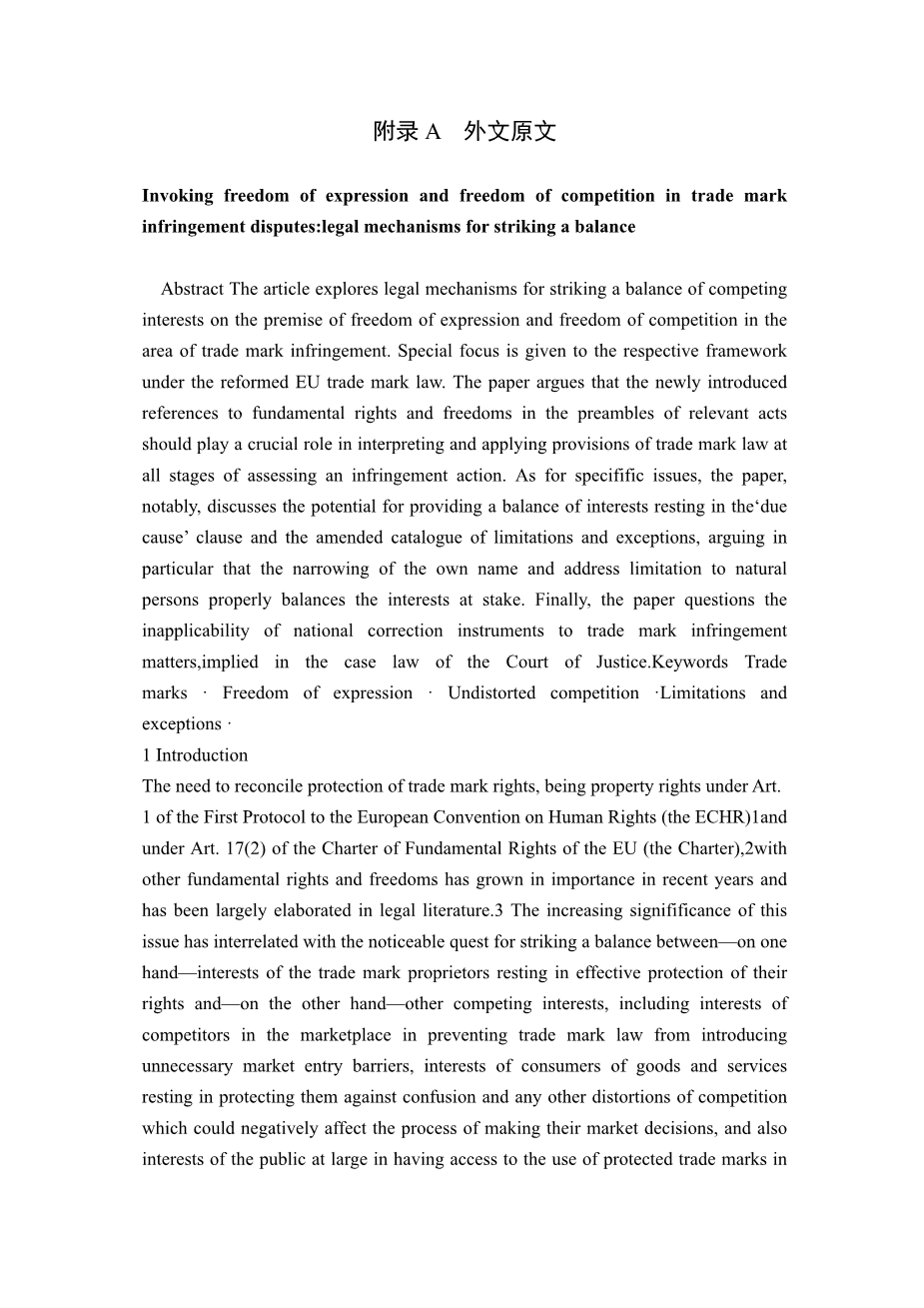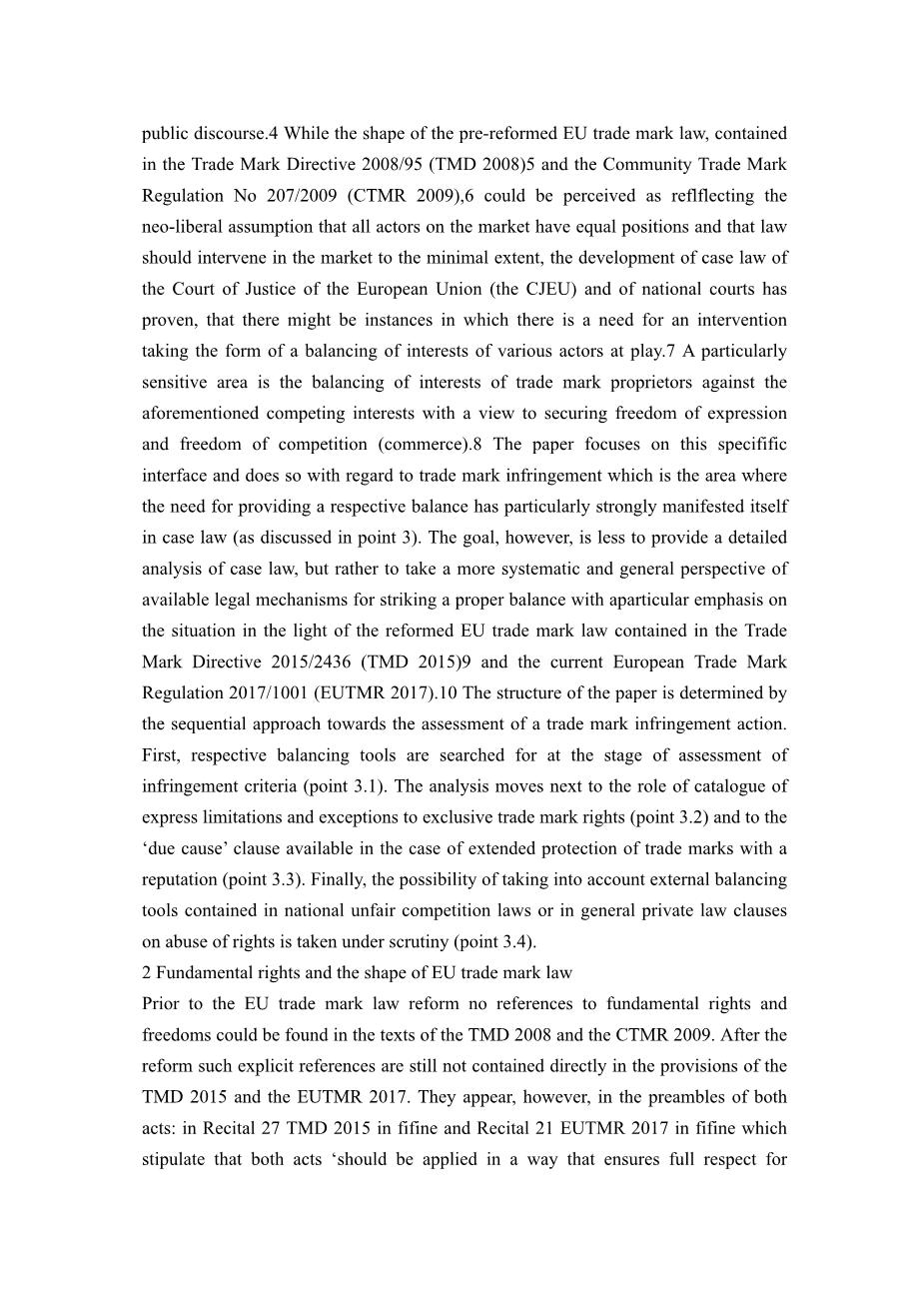

英语原文共 12 页,剩余内容已隐藏,支付完成后下载完整资料
Invoking freedom of expression and freedom of competition in trade mark infringement disputes:legal mechanisms for striking a balance
Abstract The article explores legal mechanisms for striking a balance of competing interests on the premise of freedom of expression and freedom of competition in the area of trade mark infringement. Special focus is given to the respective framework under the reformed EU trade mark law. The paper argues that the newly introduced references to fundamental rights and freedoms in the preambles of relevant acts should play a crucial role in interpreting and applying provisions of trade mark law at all stages of assessing an infringement action. As for specifific issues, the paper, notably, discusses the potential for providing a balance of interests resting in thelsquo;due causersquo; clause and the amended catalogue of limitations and exceptions, arguing in particular that the narrowing of the own name and address limitation to natural persons properly balances the interests at stake. Finally, the paper questions the inapplicability of national correction instruments to trade mark infringement matters,implied in the case law of the Court of Justice.Keywords Trade marks · Freedom of expression · Undistorted competition ·Limitations and exceptions ·
1 Introduction
The need to reconcile protection of trade mark rights, being property rights under Art.
1 of the First Protocol to the European Convention on Human Rights (the ECHR)1and under Art. 17(2) of the Charter of Fundamental Rights of the EU (the Charter),2with other fundamental rights and freedoms has grown in importance in recent years and has been largely elaborated in legal literature.3 The increasing signifificance of this issue has interrelated with the noticeable quest for striking a balance between—on one hand—interests of the trade mark proprietors resting in effective protection of their rights and—on the other hand—other competing interests, including interests of competitors in the marketplace in preventing trade mark law from introducing unnecessary market entry barriers, interests of consumers of goods and services resting in protecting them against confusion and any other distortions of competition which could negatively affect the process of making their market decisions, and also interests of the public at large in having access to the use of protected trade marks in public discourse.4 While the shape of the pre-reformed EU trade mark law, contained in the Trade Mark Directive 2008/95 (TMD 2008)5 and the Community Trade Mark Regulation No 207/2009 (CTMR 2009),6 could be perceived as reflflecting the neo-liberal assumption that all actors on the market have equal positions and that law should intervene in the market to the minimal extent, the development of case law of the Court of Justice of the European Union (the CJEU) and of national courts has proven, that there might be instances in which there is a need for an intervention taking the form of a balancing of interests of various actors at play.7 A particularly sensitive area is the balancing of interests of trade mark proprietors against the aforementioned competing interests with a view to securing freedom of expression and freedom of competition (commerce).8 The paper focuses on this specifific interface and does so with regard to trade mark infringement which is the area where the need for providing a respective balance has particularly strongly manifested itself in case law (as discussed in point 3). The goal, however, is less to provide a detailed analysis of case law, but rather to take a more systematic and general perspective of available legal mechanisms for striking a proper balance with aparticular emphasis on the situation in the light of the reformed EU trade mark law contained in the Trade Mark Directive 2015/2436 (TMD 2015)9 and the current European Trade Mark Regulation 2017/1001 (EUTMR 2017).10 The structure of the paper is determined by the sequential approach towards the assessment of a trade mark infringement action. First, respective balancing tools are searched for at the stage of assessment of infringement criteria (point 3.1). The analysis moves next to the role of catalogue of express limitations and exceptions to exclusive trade mark rights (point 3.2) and to the lsquo;due causersquo; clause available in the case of extended protection of trade marks with a reputation (point 3.3). Finally, the possibility of taking into account external balancing tools contained in national unfair competition laws or in general private law clauses on abuse of rights is taken under scrutiny (point 3.4).
2 Fundamental rights and the shape of EU trade mark law
Prior to the EU trade mark law reform no references to fundamental rights and freedoms could be found in the texts of the TMD 2008 and the CTMR 2009. After the reform such explicit references are still not contained directly in the provisions of the TMD 2015 and the EUTMR 2017. They appear, however, in the preambles of both acts: in Recital 27 TMD 2015 in fifine and Recital 21 EUTMR 2017 in fifine which stipulate that both acts lsquo;should be applied in a way that ensures full respect for fundamental rights and freedoms, and in particular the freedom of expressionrsquo;. Even though both recitals deal primarily with the issue of limitations and exceptions to exclusive trade mark rights, the framing of references to fundamental rights and freedoms can be construed as a general call for taking them into account in the process
of interpreting and applying trade mark law.11 The freedom of expression which is specififically distinguished among other fundamental rights and freedoms in the preamble of the TMD 2015 and the EUTMR 2017,is guaranteed under Art. 10(1) ECHR and Art. 11 of the Charter. In the light of the case law of the European Court of Human Rights (ECtHR) a guarantee of freedom of expression contained in Art. 10(1) ECHR applies to any
全文共32065字,剩余内容已隐藏,支付完成后下载完整资料
资料编号:[450496],资料为PDF文档或Word文档,PDF文档可免费转换为Word
您可能感兴趣的文章
- 薪酬满意度作为工作满意度的先行因素:建立一个回归模型,确定公共和私人组织中薪酬满意度与工作满意度之间的线性关系外文翻译资料
- 胜任力与胜任力、胜任力模型与胜任力模型的比较研究外文翻译资料
- 如何提高企业网络招聘的有效性外文翻译资料
- 为初级职位招聘大学生,在制定战略和战术校园招聘计划时,需要考虑哪些问题?外文翻译资料
- 基于能力的招聘:招聘和留住成功员工的关键外文翻译资料
- 员工培训对体育门票销售人员工作满意度的影响外文翻译资料
- 由雇主参与的创新型员工激励模式外文翻译资料
- 浅析企业文化与企业绩效的相关性 ——以苏州金色未来信息咨询股份有限公司为例外文翻译资料
- 互联网背景下基于平衡计分卡的计算机绩效评价系统外文翻译资料
- 提高斯洛伐克公共行政部门招聘过程的效率外文翻译资料


